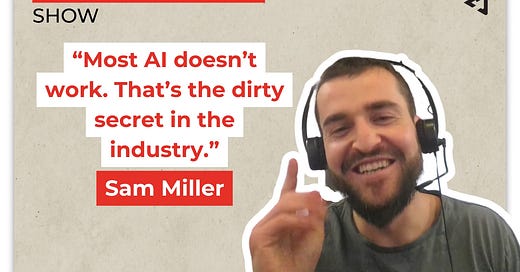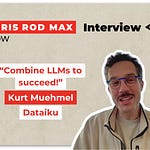In this episode of the Chris Rod Max Show, Sam Miller from Artanis shares his journey from an economist at the Bank of England to an AI entrepreneur. He discusses his passion for economics and how it led him to explore AI, eventually founding a fitness AI company.
Sam delves into the challenges of building AI, the transition from an agency model to a product-focused approach, and the importance of data labeling in creating effective AI solutions. He emphasizes the need for good work, reputation building, and the balance between service and product in the AI landscape.
In this conversation, Sam discusses the evolution of AI labeling tasks, emphasizing the shift from unambiguous labeling to subjective interpretations. He introduces the concept of ‘policy’ in AI, which aims to provide clear instructions for labelers to ensure consistent data labeling.
Sam also shares insights about his company, Artanis, which focuses on building trustworthy AI products. The discussion touches on the current state of the AI market, the importance of policy in medical AI applications, and the dynamics of investor relationships.
Sam concludes with thoughts on the future of AI and the significance of honesty in business practices.
Chapters
00:00 Introduction to AI and Personal Journey
03:12 Transition from Economics to AI
06:13 Starting a Fitness AI Company
08:57 Building AI: The Process and Challenges
12:08 From Agency to Product Company
15:04 Navigating the AI Agency Landscape
18:11 Scaling AI Services vs. Products
21:07 The Importance of Data Labeling in AI
23:52 Core Principles of Building Effective AI
25:57 The Evolution of AI Labeling Tasks
29:26 Defining Policy in AI Labeling
31:15 Artanis: Building Trustworthy AI Products
33:27 Current State of AI Market
36:34 Policy Implementation in Medical AI
40:14 Understanding Investor Dynamics
43:42 The Importance of Truth in Business
44:57 Future Prospects of AI in Everyday Life
Takeaways
Exercise Caution with Current AI Solutions Sam explicitly warned: "AI solutions don't work perfectly right now. Don't buy one if someone's trying to sell you one." This is a crucial red flag for enterprises to be skeptical of vendors promising fully automated AI solutions. The emphasis on human-in-the-loop implementations suggests that enterprises should expect to maintain significant human oversight of any AI systems they deploy.
Focus on Specific Policies Rather Than Vague Capabilities When evaluating AI solutions, enterprises should look for vendors who can articulate specific, concrete policies for their AI systems rather than making broad claims. As Sam illustrated, vague instructions like "be the world's best doctor" are less valuable than specific policies like "tell users who are having a stroke to go to the hospital." Enterprise buyers should demand clear, testable specifications for AI behavior.
Look for Natural Language Interface Potential Sam highlighted that in the next five years, AI will transform the human-computer interface to natural language, "opening up opportunities for people who don't like traditional computer interfaces to get more value from software." For enterprises, this suggests evaluating AI solutions not just for their core functionality, but for their potential to make complex systems more accessible to a broader range of employees through natural language interactions.
YouTube Episode
Spotify Podcast
Episode Transcript
Maxson Tee: Welcome to the Chris Rod Max Show. Today we have a special guest, Sam, joining us along with our co-host Rod. Chris is also with us from a café somewhere. Sam, great to have you here.
Sam: Thanks! Yes, I'm currently at ***, though I'd almost rather be in that café given what these folks know about AI [laughs]. But I'm just kidding - they're really smart people here. I want to give a shout-out to Boulderton because they've generously given us free space for six months. We've met great people and gotten excellent advice, even though we occasionally have different views on AI.
Career Journey: From Economics to AI
Maxson Tee: Perfect! Let's start with your background. You went from being an economist at the Bank of England to working in AI. Could you walk us through that journey?
Sam: I studied economics at university and really loved it. I wasn't particularly motivated by money - I wanted to have a macro-scale impact on society and policy. The Bank of England seemed like a good way to do that. I thought, 'If I could tweak the right knob for the government, I could impact the whole society.'
The reality of policymaking as a 22-year-old was different, of course. You're not the one tweaking the knobs - you're writing documents that people usually ignore. But half my job was research, which I really enjoyed. I had the unusual opportunity to write economic research papers without a PhD, thanks to a supportive manager.
Working in the public sector meant the job wasn't too intense, so I started learning Python as a hobby. The first time I wrote a for loop, I was amazed - 'Wow, it can do a million things in a second!' I got into machine learning initially just to improve my Python skills.
My background in econometrics, which is essentially applied statistics, had significant overlap with machine learning. This led me to apply for a machine learning AI PhD at the Alan Turing Institute. They make exceptions for people without CS backgrounds, and thanks to my published research, I got in. The transition from economics to AI isn't as dramatic as it might seem - economics and econometrics are actually great backgrounds for AI, though you do need to learn programming.
First Startup Experience
Maxson Tee: After your PhD, you started a company, right?
Sam: Actually, let me correct that - I started my first company nine months into my PhD, not after it. It's been over seven years now, so I can talk about it freely.
Maxson Tee: Tell us about that venture. Was it related to fitness?
Sam: Yes, but in an interesting way. I used to compete in powerlifting during university - bench press, squat, deadlift, lifting as heavy as possible. I once burst a blood vessel in my eye during a squat competition, which the other lifters thought was pretty impressive!
I enjoyed teaching people about weightlifting and coached many friends and colleagues from the Bank of England through WhatsApp. They'd send me videos of their form, and I could always spot how to improve it.
At the Turing Institute, I sat next to someone running a computer vision lab working on pose estimation, or skeleton tracking - determining body coordinates from images or videos. I realized my weightlifting coaching was essentially about body coordinates: 'hips need to be lower than knees at the bottom of the squat.' We could create an AI version of my WhatsApp coaching - an AI personal trainer to solve the problem of poor form in the gym.
Building the First AI Product
Maxson Tee: That's fascinating! Can you tell us about the process of building that AI?
Sam: The technology worked quite quickly because there had been significant advances in pose estimation. We could use pre-trained models rather than training our own. When we got it working fast, I thought, 'We're going to be billionaires! We have fancy technology and a great idea!'
My co-founder had a strong background as a strategy consultant from one of the big consultancies. When he quit his job to join, people from his previous startup invested, and we quickly raised an angel round based mainly on his connections. We thought it would only take six months to build. That was Atlas.
The Agency Journey
Rod: You've been working as an agency, and now you're transforming into a product company. What's the current situation with AI agencies? There's discussions about agencies achieving product-like margins through automation.
Sam: The way we kept Atlas going for four or five years was interesting. We raised about 500K over four years - not much in the tech world for a team of five. Because my colleague and I both had AI PhDs, companies would occasionally email us after seeing Atlas, not wanting to buy our product but wanting to pay us to build their AI.
Initially, we would decline because we were focused on the fitness app. But when money got tight, we started taking these projects to fund Atlas. Eventually, we realized we'd pivoted far from our original vision - we'd gone from being powerlifters making a strength training app to counting star jumps in living rooms.
Building Trust in AI
Sam: The key problem in AI right now is trust. Most AI being deployed is human-in-the-loop because people don't actually trust that it works. At Artanis, we've developed something we call 'policy,' which we believe is the missing core of the AI stack.
Medical triage as an example. If you have a bot deciding whether people should go to the hospital, different doctors might have different policies. You can't start with vague instructions like 'You're the world's best doctor, answer accurately and reliably.' You need specific policies: 'Tell users who are having a stroke to go to the hospital.'
The Future of AI
Maxson Tee: What excites you most about AI in the next five years?
Sam: First, let me caveat: AI solutions don't work perfectly right now. Don't buy one if someone's trying to sell you one. But in five years, I think AI agents will work - you'll be able to give high-level instructions like 'book a meeting with Rod next week' and the agent will handle all the details.
This is compelling because it changes the human-computer interface to natural language, opening up opportunities for people who don't like traditional computer interfaces to get more value from software.
Closing Thoughts
Rod: Where can people find you and learn more?
Sam: You can visit artanis.ai to subscribe to our content on Substack or our monthly updates. You can also email me directly at sam@artanis.ai - if I get too many emails to respond to, that's a great problem to have! We'd love to hear any feedback, including thoughts on this podcast.
Rod: Thank you, Sam, for joining us. Everyone, don't forget to like, subscribe, and check out ChrisRodMax.com for our newsletter.
Sam: Thank you guys, appreciate it.
Maxson Tee: Thank you.
Your Hosts
Follow
Social
X: ChrisRodMax
Instagram: ChrisRodMax
LinkedIn: Company Page
Subscribe: Website
Tags: #chrisrodmax #ai #technews














Share this post